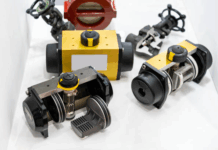Ammonia is a cornerstone chemical in industries such as fertilizer production, chemical manufacturing, and food processing. However, its widespread use comes with a significant downside: ammonia emissions. These emissions pose serious risks to human health—causing respiratory problems, eye irritation, and, in extreme cases, even death—and contribute to environmental degradation by forming particulate matter and other pollutants. According to the Environmental Protection Agency (EPA), ammonia ranks among the most produced industrial chemicals in the United States, with millions of tons released into the atmosphere each year. This underscores the urgent need for effective air pollution control solutions. Among the most reliable technologies available, ammonia scrubbers—particularly wet scrubbers—stand out as a powerful tool for capturing and neutralizing ammonia gas from industrial exhaust streams, ensuring safer workplaces and cleaner air.
What is an Ammonia Scrubber?
An ammonia scrubber, often called an ammonia gas scrubber, is a specialized device designed to remove ammonia from industrial exhaust gases. As a type of wet scrubber, it employs a liquid—typically an acidic solution—to capture and neutralize ammonia gas, preventing its release into the environment. These systems are vital for industries where ammonia is a byproduct, helping them comply with strict environmental regulations while safeguarding worker and community health. For a deeper dive into how these systems are engineered, including the critical calculations behind their design, check out this comprehensive resource on ammonia scrubber design and calculation.
How Does a Wet Scrubber Work for Ammonia Removal?
The operation of an ammonia gas scrubber ,a type of wet scrubber designed specifically for ammonia removal—is both elegant and efficient. The process begins as the ammonia-laden gas stream enters the scrubber and comes into contact with a scrubbing liquid, typically a dilute solution of sulfuric acid or another suitable acid. As the gas passes through the system, ammonia molecules dissolve into the liquid and react chemically with the acid, forming stable ammonium salts. For example, when sulfuric acid is used, the reaction yields ammonium sulfate—a valuable compound that can be reused as a fertilizer. This combination of effective pollutant elimination and byproduct recovery makes the ammonia gas scrubber an especially attractive solution for emissions control.
Several types of wet scrubbers can tackle ammonia removal, each suited to different industrial needs:
- Packed Bed Scrubbers: These feature a bed of packing material that maximizes the surface area for gas-liquid contact, boosting absorption efficiency.
- Spray Towers: Equipped with nozzles, these spray the scrubbing liquid into the gas stream, creating droplets that trap ammonia.
- Venturi Scrubbers: These accelerate the gas through a narrow section where it mixes with the liquid, achieving high removal rates.
The choice of scrubber depends on variables like gas flow rate, ammonia concentration, and available space. Success hinges on optimizing contact between gas and liquid, maintaining the scrubbing solution’s pH and concentration, and performing regular maintenance to avoid issues like scaling or corrosion.
Benefits of Using Ammonia Scrubbers
The advantages of ammonia scrubbers are manifold. Chief among them is their ability to slash ammonia emissions, enabling industries to meet stringent environmental standards. By neutralizing ammonia gas before it escapes into the atmosphere, scrubbers reduce air pollution and mitigate associated health risks. They also enhance workplace safety by limiting workers’ exposure to toxic ammonia vapors.
Beyond compliance and safety, ammonia scrubbers offer economic perks. The production of valuable byproducts, such as ammonium sulfate, can offset costs by being sold or reused. Their adaptability—customizable to specific industrial processes—makes them a versatile choice across sectors. Moreover, adopting such technology burnishes a company’s reputation as an environmentally conscious entity, fostering goodwill among stakeholders. Finally, scrubbers allow operations to stay within legal limits without sacrificing production efficiency, a win-win for profitability and sustainability.
Key Considerations in Designing an Ammonia Scrubber
Crafting an effective ammonia scrubber demands attention to detail. The gas flow rate and ammonia concentration in the exhaust stream are foundational metrics; higher values may necessitate larger or more advanced scrubber designs to ensure effective removal. The scrubbing liquid’s selection is equally critical—sulfuric acid is a go-to, but alternatives like phosphoric or citric acid might suit specific needs or desired byproducts. The acid’s concentration must strike a balance: sufficient to react fully with ammonia yet economical in use.
Temperature also plays a role; hotter gas streams can reduce ammonia’s solubility, sometimes requiring pre-cooling. Material choice for the scrubber’s construction must resist corrosion, while the layout of packing material or nozzles should maximize contact area. Effective liquid recirculation and disposal systems round out the design essentials. Given these complexities, expert guidance or detailed resources can be invaluable. For instance, explore this guide on ammonia gas scrubber design calculations to inform your approach. A well-executed design can achieve removal efficiencies above 99%, meeting environmental goals without compromising performance.
Conclusion
Ammonia scrubbers are indispensable for industries handling ammonia, offering a robust solution to control emissions while protecting health and the environment. Understanding their operation and design intricacies empowers companies to implement them effectively. If your facility grapples with ammonia emissions, a high-quality ammonia scrubber is a worthy investment for compliance and sustainability.









